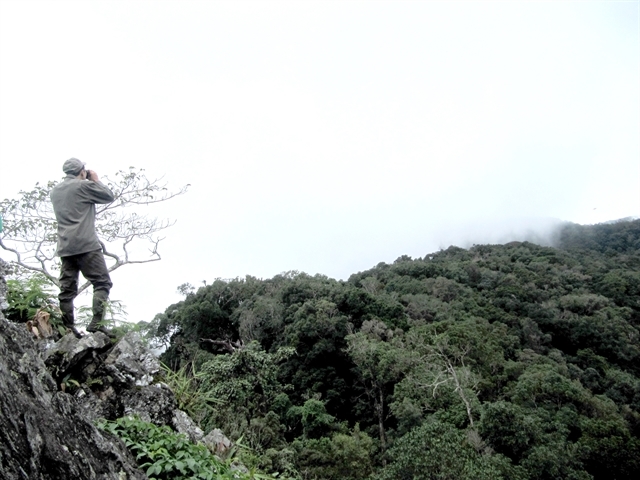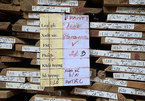The critically endangered species include the grey-shanked douc langur (Pygathrix Cinerea), the northern buffed-cheek gibbon (Nomascus annamensis), Owston’s palm civet (Chrotogale owston), and the Golden-winged Laughingthrush (Trochalopteron ngoclinhense).

Recent field surveys and camera trap projects, jointly organised by Fauna&Flora International (FFI), a conservation NGO from the UK, the Centre for Biodiversity Conservation, GreenViet, and Germany’s Leibniz Institute for Zoo and Wildlife Research (IZW), found nearly 500 grey-shanked douc langurs, 143 northern buffed-cheek gibbons, and 121 other species living in Kon Plong’s well-preserved 84,000ha of primary forest.
The existence of relatively large populations of endangered species would normally result in a forest area becoming a national nature reserve and possibly being the focus of sustainable development efforts if it’s also in a poor mountainous district.
At a recent conference on biodiversity conservation and sustainable livelihoods in Kon Plong, held in Kon Tum City, conservationists agreed that its forest should become a national nature reserve or national park to conserve the endangered animals.
Nguyen Quoc Dung, an expert from the Forest Inventory and Planning Institute (FIPI) at the Ministry of Agriculture and Rural Development, suggested that the Kon Plong forest be turned into a national park based on its rich population of these endangered primates before links are expanded with other reserves in Kon Tum and neighbouring Gia Lai, Quang Ngai and Quang Nam provinces, to create a ring of enlarged reserves in central Vietnam with international status.
“It’s a great opportunity to make Kon Plong forest, which has been well-preserved and has a number of endangered species, a national park,” he said.
“It becoming a national park would be suitable for the province’s sustainable eco-tourism and high-tech farming zone in Mang Den, and biodiversity chain including the nature reserves of Chư Mon Rây, the Ngoc Linh ginseng reserve, and Dak Uy forest,” he emphasised.
Kon Plong forest could become an attractive eco-tourism site based on biodiversity conservation and a global flora and fauna research destination, so conservation must be a top priority.
Dung, however, expressed some concern, as the well-preserved 84,000ha of primary forest in Kon Plong is not yet included in the provincial special-use forest plan or the national forestry plan.
National treasure
Josh Kempinski, country director of FFI, said Kon Plong is one of the most important forests outside of Việt Nam’s special-use forest network, and its outstanding biodiversity is of great national and global importance.
“Kon Plong is a vital part of Việt Nam’s national heritage and is a national treasure,” he said.
“It is also highly strategic, and irreplaceable, forming the only forest connection, or corridor, between the central and southern Annamites [as the Central Highlands is known].
“FFI is supporting the proposal that the rich, natural forest of Kon Plong be conserved for future generations as the East Annamites Nature Reserve. Outside of its boundaries, FFI envisages a mosaic landscape of eco-tourism development, green agriculture, and commercial forest development.”
FFI sees forest protection as a key part of sustainable development for the benefit of all.
“We first started working in Kon Tum in 2010, with a small pilot programme on reducing emissions from deforestation and degradation (REDD), which has expanded over the years, and are dedicated to helping conserve the wider Kon Plong forest landscape,” he said.
Hoang Van Lam, an expert with FFI, said the Kon Plong forest, which includes two forest zones (Thạch Nham and Kon Plong) managed by two State-owned units, had been well preserved and overseen and needed to become one of the most important protection sites in central Việt Nam.
He said re-planning was needed in regard to how to expand protective boundaries as a safe habitat for the grey-shanked douc langurs and the northern buffed-cheek gibbon -- the two key primates -- and other endangered animals on the IUCN Red List.
Lâm added that recent surveys revealed that only 34 per cent of the grey-shanked douc langur population was found living inside the 35,000-ha Thach Nham forest within Kon Plong.
“The boundaries need to be reset by the two forest owners to ensure that a protection boundary exists for endangered species living in the safe habitat zone,” he said.
He warned that snares and traps as well as illegal hunting activities were all-too-common in the area, and turning forest zones into protective areas with better legal enforcement was very much needed.
Kon Plong forest could be a starting point for a large “green” corridor that links other nature reserves in the province and Quang Ngai and Quang Nam, on 210,000ha, along a 40-km inter-provincial forest range.
Considering livelihoods
Though earning a total of VND30 billion (US$1.3 million) from forest protection each year, half of the 28,500 people in the local area, including members of the Ca Dong, Xơ Đăng and M'Nông ethnic minorities, still live in poverty, according to a report.
In mapping out the development of sustainable livelihoods, the province has planned a 170-ha high-tech farming area, 2,750ha of medicinal herb farms, and a 4,750-ha eco-tourism zone.
A resident of Dak Tang Commune, A Hung, said local people preferred flexible policies that would change the livelihoods of the ethnic groups surrounding Kon Plong forest.
Seventy per cent of this population had been assigned to protect 60 to 80 per cent of the primary forest in the district, but farming medicinal herbs or making non-timber and forestry products were not yet allowed.
He said the community had established teams of guards to join patrols and protection activities with forest rangers.
“Our prosperity has derived from the forest, which gave our ancestors a traditional livelihood,” Hùng said. “Protection means creating sources for different forestry products. The ethnic communities in the area have a forest-based attitude.”
“Medicinal herb farming and community-based eco-tourism would help us improve our earnings from the ‘natural treasure’, while the community would act as guards to protect the ‘green’ forest over the generations.”
VNS

Export prospects rise though forestry decree
With the EU being among the largest importers of Vietnam’s timber products, a fresh decree on legal assurance has marked an important step towards the full implementation of the Forest Law Enforcement,
FFI,